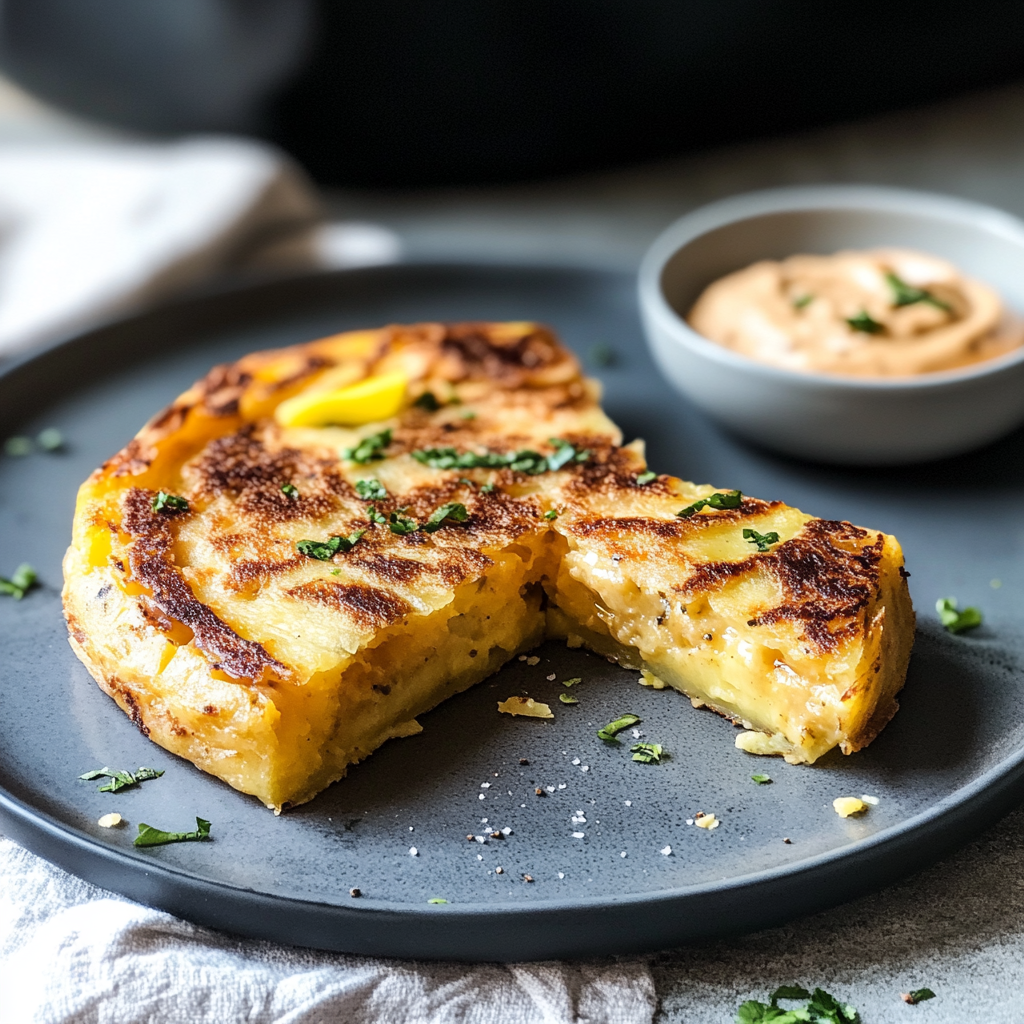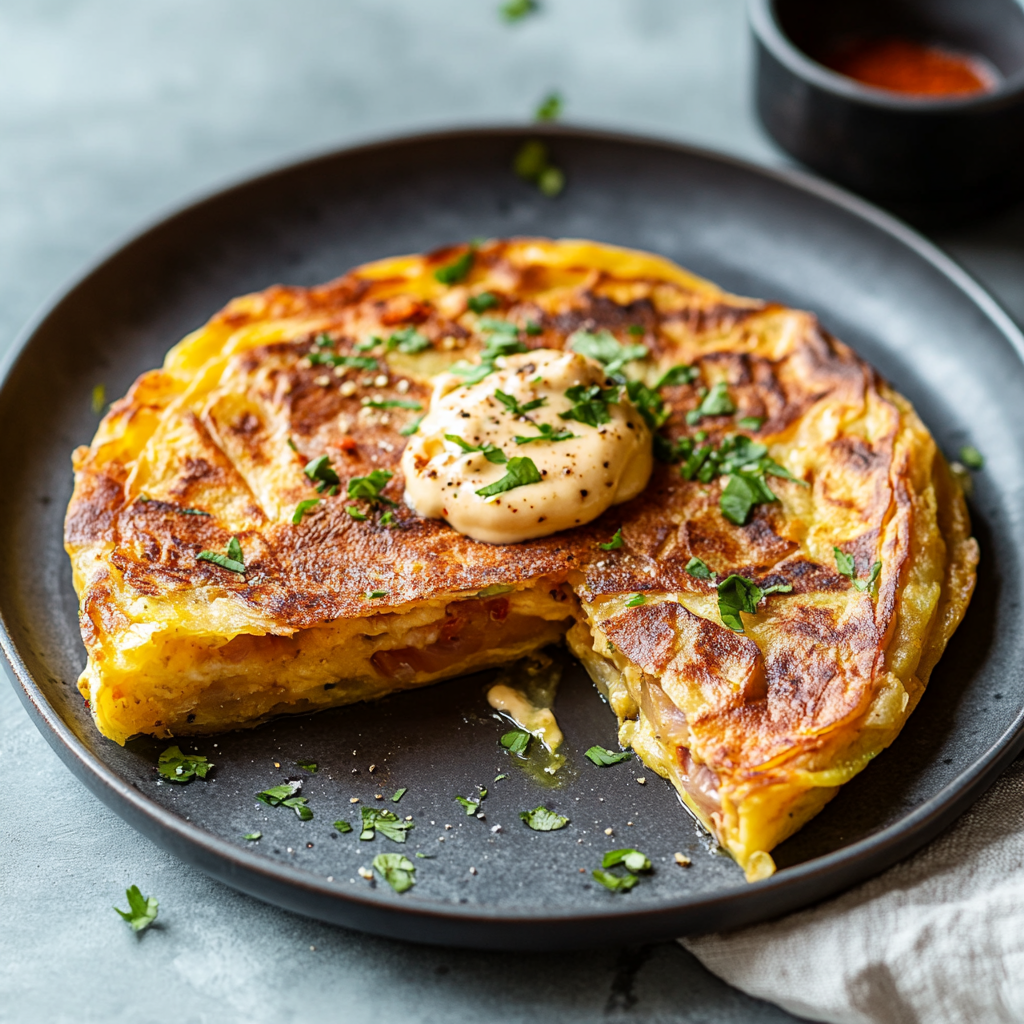The Spanish tortilla, also known as “tortilla de patatas,” is a beloved dish hailing from Spain. This dish is simple yet rich in flavor, featuring a thick omelet made from potatoes, onions, and eggs. Its appeal lies in its versatility and comforting nature. When paired with a smoky and creamy Pimentón Aioli, this dish reaches new heights of flavor and sophistication. Whether you’re preparing it for a tapas night or a family meal, this Spanish classic is guaranteed to impress.
Ingredients for Spanish Tortilla
- 6 medium potatoes (preferably waxy varieties like Yukon Gold)
- 1 large onion, thinly sliced
- 6 large eggs
- 1 cup olive oil (for frying)
- Salt to taste
Directions for Spanish Tortilla
- Prepare the Potatoes and Onions: Peel and thinly slice the potatoes into even rounds or half-moons. Heat olive oil in a large frying pan over medium heat. Add the potatoes and onions and cook gently, stirring occasionally. The goal is to soften them, not crisp them.
- Drain the Oil: Once tender, remove the potatoes and onions using a slotted spoon and drain them on a paper towel. Reserve the oil for future use.
- Beat the Eggs: In a large bowl, beat the eggs lightly. Add a pinch of salt and stir in the drained potato-onion mixture.
- Cook the Tortilla: Heat a small amount of the reserved oil in the pan over medium-low heat. Pour the egg mixture into the pan and spread it evenly. Cook for 6-8 minutes, until the edges set but the center remains slightly runny.
- Flip the Tortilla: Place a large plate over the pan and carefully flip the tortilla onto the plate. Slide it back into the pan and cook the other side for an additional 4-5 minutes.
- Rest and Serve: Transfer the tortilla to a serving plate and allow it to rest for a few minutes before serving.
Ingredients for Pimentón Aioli
- 1 garlic clove, minced
- 1 egg yolk
- 1 cup olive oil
- 1 teaspoon lemon juice
- 1 teaspoon pimentón dulce (smoked paprika)
- Salt to taste
Directions for Pimentón Aioli
- Whisk the Egg Yolk: In a medium bowl, whisk the egg yolk with a pinch of salt until creamy.
- Incorporate Olive Oil: Slowly drizzle in the olive oil while whisking continuously to emulsify the mixture into a thick, creamy consistency.
- Add Flavors: Mix in the minced garlic, lemon juice, and pimentón dulce. Taste and adjust seasoning if needed.
- Serve or Store: Use immediately or store in an airtight container in the refrigerator for up to 3 days.
Nutrients
While specific nutritional values are not provided, the Spanish tortilla is a hearty and nutrient-rich dish. It combines eggs, which are a great source of protein, with potatoes for complex carbohydrates. Olive oil provides healthy fats. The Pimentón Aioli adds richness with its olive oil and egg yolk base, along with the antioxidant properties of garlic and smoked paprika.
The Spanish Tortilla, also known as “Tortilla de Patatas,” is a quintessential dish in Spanish cuisine. This humble yet satisfying omelet, made from a base of potatoes, onions, and eggs, has been a staple in Spanish homes for centuries. Its origin is steeped in history, with claims of its invention dating back to the 19th century, though there are numerous theories about where and when the dish first appeared. Some say it was created during times of famine as a way to make the most of limited ingredients, while others argue that it was the result of culinary experimentation in rural Spain. Regardless of its origin, the Spanish tortilla has remained a beloved comfort food, appreciated for its simplicity, versatility, and heartiness.
The Essence of the Spanish Tortilla
At its core, the Spanish tortilla is about balance and technique. The simplicity of the ingredients—potatoes, onions, and eggs—makes this dish approachable and appealing to a wide audience. The key to a perfect tortilla lies in the way the ingredients are prepared. Potatoes, typically waxy varieties such as Yukon Gold, are sliced thinly and gently fried until tender. Onions, which add a touch of sweetness, are cooked alongside the potatoes to infuse the dish with flavor. The eggs, lightly beaten, are then mixed with the cooked vegetables and set to cook gently in a pan. The end result is a thick, slightly golden omelet that is crisp on the outside and tender on the inside.
One of the unique characteristics of a Spanish tortilla is its texture. Unlike an American-style omelet, which is often thin and quick to cook, the Spanish tortilla is thicker, requiring a slow and careful cooking process. The result is a rich, comforting dish that is perfect for breakfast, lunch, or dinner. It can be served warm or at room temperature, making it ideal for picnics, tapas spreads, or as a main course for a family meal. The versatility of the Spanish tortilla means it can be enjoyed in various settings, from casual gatherings to more formal occasions.

The Role of Pimentón Aioli
While the Spanish tortilla is delicious on its own, pairing it with a smoky, creamy Pimentón Aioli elevates the dish to a new level of sophistication and flavor. Aioli, a Mediterranean sauce made from garlic and olive oil, is a perfect accompaniment to the rich, savory flavors of the tortilla. The addition of pimentón, or smoked paprika, gives the aioli a depth of flavor that complements the earthiness of the potatoes and the sweetness of the onions. The smoky undertones of the pimentón add a layer of complexity that enhances the overall dining experience.
Pimentón Aioli is made by whisking together egg yolk, olive oil, garlic, lemon juice, and smoked paprika. The aioli can be made in advance and stored in the refrigerator, allowing the flavors to meld and intensify. When served alongside the Spanish tortilla, it provides a creamy contrast to the soft texture of the eggs and potatoes, while the smokiness of the pimentón adds an aromatic quality that is truly unforgettable. Whether drizzled over the tortilla or served on the side for dipping, Pimentón Aioli brings an exciting new dimension to this traditional Spanish dish.
Variations of the Spanish Tortilla
Though the classic Spanish tortilla recipe is beloved for its simplicity, it also lends itself to various adaptations and variations. Depending on the region, the tortilla may include additional ingredients such as chorizo, bell peppers, or even spinach. Some versions are made with a higher proportion of eggs, resulting in a fluffier texture, while others are cooked with a heavier hand on the oil, yielding a crispier exterior. These variations offer endless possibilities for customization, allowing the dish to suit different tastes and preferences.
In some regions of Spain, it is common to add other ingredients to the tortilla, such as bell peppers or asparagus, to enhance the flavor and create a more colorful dish. In Catalonia, for example, a popular variation includes adding green peas to the mix. The beauty of the Spanish tortilla lies in its flexibility; it can be adapted to suit seasonal ingredients or individual preferences. However, despite these variations, the fundamental elements of potatoes, onions, and eggs remain unchanged, ensuring that the dish retains its distinctive character.
The Spanish Tortilla as a Cultural Symbol
The Spanish tortilla is more than just a dish; it is a cultural symbol that reflects the values and traditions of Spain. In many ways, it embodies the concept of “slow food”—a dish that is made with care and attention to detail, using simple, high-quality ingredients. The tortilla is a dish that is passed down through generations, with families often having their own secret methods for preparing it. In Spain, it is common for families to gather around the table to share a tortilla, whether it be for a midday meal or a late-night snack.
The tortilla is also an essential part of Spain’s tapas culture. Tapas, small dishes served alongside drinks, are a cornerstone of Spanish dining, and the Spanish tortilla is often featured prominently on tapas menus. It is a dish that transcends mealtimes, appearing at picnics, parties, and celebrations. The tortilla’s widespread popularity is a testament to its enduring appeal and its ability to bring people together over good food.
Conclusion
The Spanish tortilla is a dish that encapsulates the heart and soul of Spanish cuisine. Simple yet rich in flavor, it offers a satisfying combination of potatoes, onions, and eggs that is both comforting and versatile. Whether served as a main course or as part of a tapas spread, it is a dish that is sure to impress. When paired with a smoky and creamy Pimentón Aioli, the Spanish tortilla reaches new heights of flavor, providing a perfect balance of textures and tastes.
Incorporating the Spanish tortilla into your repertoire allows you to connect with the rich culinary traditions of Spain while adding your own personal touch. Whether you stick to the classic recipe or experiment with different variations, this dish offers endless possibilities for creativity and enjoyment. And with its appeal across generations and cultures, the Spanish tortilla is sure to continue its legacy as a beloved comfort food for years to come.







